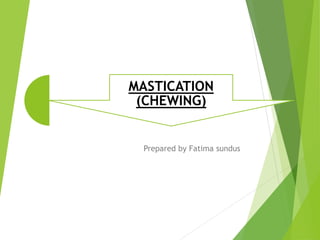
MASTICATION AND SWALLOWING.pptx
- 1. MASTICATION (CHEWING) Prepared by Fatima sundus
- 3. Mastication (Chewing) The teeth are admirably designed for chewing.
- 5. • The anterior teeth (incisors) provide a strong cutting action • The posterior teeth (molars) a grinding action • All the jaw muscles working together can close the teeth with a force as great as 55 pounds on the incisors and 200 pounds on the molars.
- 7. Most of the muscles of chewing are innervated by the motor branch of the fifth cranial nerve, and the chewing process is controlled by nuclei in the brain stem. .
- 11. • Much of the chewing process is caused by a chewing reflex. • The presence of a bolus of food in the mouth at first initiates reflex inhibition of the muscles of mastication, which allows the lower jaw to drop. • The drop in turn initiates a stretch reflex of the jaw muscles that leads to rebound contraction. • This automatically raises the jaw to cause closure of the teeth, but it also compresses the bolus again against the linings of the mouth, • which inhibits the jaw muscles once again, allowing the jaw to drop and rebound another time • this is repeated again and again.
- 14. Digestive enzymes act only on the surfaces of food particles; therefore, the rate of digestion is absolutely dependent on the total surface area exposed to the digestive secretions
- 16. Role of pharynx in swallowing • It subserves both respiration & swallowing • It is converted into a tract for propulsion of food for only a few seconds at a time • It is specially important that respiration not be compromised because of swallowing
- 18. (1) a voluntary Stage (oral stage) which initiates the swallowing process (2) a pharyngeal stage which is involuntary and constitutes passage of food through the pharynx into the esophagus (3) an esophageal stage another involuntary phase that transports food from the pharynx to the stomach.
- 19. Voluntary Stage of Swallowing. When the food is ready for swallowing, it is “voluntarily” squeezed or rolled posteriorly into the pharynx by pressure of the tongue upward and backward against the palate.
- 28. • Primary peristalsis is simply continuation of the peristaltic wave that begins in the pharynx and spreads into the esophagus during the pharyngeal stage of swallowing. • This wave passes all the way from the pharynx to the stomach in about 8 to 10 seconds. • Food swallowed by a person who is in the upright position is usually transmitted to the lower end of the esophagus even more rapidly than the peristaltic wave itself, in about 5 to 8 seconds, because of the additional effect of gravity pulling the food downward.
- 29. • secondary peristaltic waves result from distention of the esophagus itself by the retained food; these waves continue until all the food has emptied into the stomach. • The secondary peristaltic waves are initiated partly by intrinsic neural circuits in the myenteric nervous system and partly by reflexes that begin in the pharynx and are then transmitted upward through vagal afferent fibers to the medulla and back again to the esophagus through glossopharyngeal and vagal efferent nerve fibers. • When the vagus nerves to the esophagus are cut, the myenteric nerve plexus of the esophagus becomes excitable enough after several days to cause strong secondary peristaltic waves even without support from the vagal reflexes. Therefore, even after paralysis of the brain stem swallowing reflex, food fed by tube or in some other way into the esophagus still passes readily into the stomach.
- 30. At the lower end of the esophagus, extending upward about 3 centimeters above its juncture with the stomach, the esophageal circular muscle functions as a broad lower esophageal sphincter, also called the gastroesophageal sphincter.